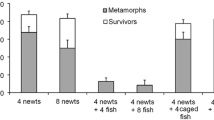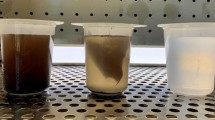Abstract
Eastern mosquitofish (Gambusia holbrooki) are native to the southeastern United States but notoriously invasive elsewhere, and are aggressive predators in ecosystems they inhabit. Information on dispersal behavior is needed to better understand mosquitofish spread upon introduction and potential means to mitigate that spread. We experimentally tested the effects of shallow water depths (3–24 mm) and obstacles (leaf litter) on mosquitofish dispersal behavior, plus a range of conditions relevant to field situations. Mosquitofish dispersed significantly faster in deeper water (p < 0.001) but some dispersed in only 3 mm water depth (i.e., one-half average body depth). Wetland and upland leaf litter at natural densities strongly interfered with mosquitofish dispersal behavior. Based on our results, introduced mosquitofish spread rapidly given unimpeded dispersal corridors (e.g., mowed ditches), and may do so at rates >800 m/day. Also, consistent lack of sexual dimorphism in dispersal behavior indicates that mosquitofish spread is not strongly dependent on female poeciliid reproductive biology. Our results support designation of mosquitofish as highly invasive and suggest that barriers to mosquitofish spread must obstruct dispersal pathways as shallow as 3 mm depth.


Similar content being viewed by others
References
Abrahams MV, Dill LM (1989) A determination of the energetic equivalence of the risk of predation. Ecology 70:999–1007
Arthington AH, Lloyd LN (1989) Introduced poeciliids in Australia and New Zealand. In: Meffe GK, Snelson FF (eds) Ecology and evolution of livebearing fishes (Poeciliidae). Prentice Hall, Englewood Cliffs, NJ
Bradford MJ, Taylor GC (1997) Individual variation in dispersal behavior of newly emerged chinook salmon (Oncorhynchus tshawytscha) from the Upper Fraser River, British Columbia. Can J Fish Aquat Sci 54:1585–1592
Chesser RK, Smith MW, Smith MH (1984) Biochemical genetics of mosquitofish. III. Incidence and significance of multiple insemination. Genetica 64:77–81
Courtenay WR, Meffe GK (1989) Small fishes in strange places: a review of introduced Poeciliids. In: Meffe GK, Snelson FF (eds) Ecology and evolution of livebearing fishes (Poeciliidae). Prentice Hall, Englewood Cliffs, NJ, pp 333–348
Duryea R, Donnelly J, Guthrie D et al (1996) Gambusia affinis effectiveness in New Jersey mosquito control. Proceedings of the 83rd Meeting of the New Jersey Mosquito Control Association, Inc., pp 95–102
Ehrlich PR (1986) Which animal will invade? In: Mooney HA, Drake JA (eds) Ecology of biological invasions of North America and Hawaii. Springer-Verlag, New York, pp 79–95
Gamradt SC, Kats LB (1996) Effect of introduced crayfish and mosquitofish on California newts. Conserv Biol 10:1155–1161
Gilliam JF, Fraser DF (1987) Habitat selection under predation hazard: test of a model with foraging minnows. Ecology 68:1856–1862
Gilpin ME, Hanski IA (eds) (1997) Metapopulation biology: ecology, genetics, and evolution. Academic Press, New York
Goodsell JA, Kats LB (1999) Effect of introduced mosquitofish on pacific treefrogs and the role of alternative prey. Conserv Biol 13:921–924
Holway DA, Suarez AV (1999) Animal behavior: an essential component of invasion biology. TREE 14:328–330
Lowe S, Browne M, Boudjelas S et al (2000) 100 of the world’s worst invasive alien species—a selection from the Global Invasive Species Database. Invasive Species Specialist Group, World Conservation Union
Julliard R (2000) Sex-specific dispersal in spatially varying environments leads to habitat-dependant evolutionary stable offspring sex ratios. Behav Ecol 11:421–428
Leyse KE, Lawler SP, Strange T (2004) Effects of an alien fish, Gambusia affinis, on an endemic California fairy shrimp, Linderiella occidentalis: implications for conservation of diversity in fishless waters. Biol Consev 118: 57–65
Lloyd LN, Arthington AH, Milton DA (1986) The mosquitofish—a valuable mosquito-control agent or a pest? In: Kitching RL (ed) The ecology of exotic animals and plants: some Australian case histories. Wiley and Sons, Brisbane, pp 6–27
Meffe GK (1985) Predation and species replacement in American Southwestern fishes: a case study. Southwest Nat 30:173–187
Meffe GK, Hendrickson DA, Minckley WL et al (1983) Factors resulting in decline of the Sonoran topminnow (Atheriniformes: Poeciliidae) in the United States. Biol Conserv 25:135–159
Meffe GK, Snelson FF Jr (1989) An ecological overview of poeciliid fishes. In: Meffe GK, Snelson FF (eds) Ecology and evolution of livebearing fishes (Poeciliidae). Prentice Hall, Englewood Cliffs, NJ, pp 13–32
Parker IM, Reichard SH (1998) Critical issues in invasion biology for conservation science. In: Fiedler PL, Kareiva PM (eds) Conservation biology for the coming decade, 2nd ed. Chapman Hall, New York, pp 283–305
Proctor MF, McLellan NB, Strobeck C et al (2004) Gender-specific dispersal distances of grizzly bears estimated by genetic analysis. Can J Zool 82:1108–1118
Pyke GH (2005) A review of the biology of Gambusia affinis and G. holbrooki. Rev Fish Biol Fisheries 15:339–365
Rahel FJ (2002) Homogenization of freshwater faunas. Ann Rev Ecol System 33:291–315
Ralls K, Brugger K, Ballou J (1979) Inbreeding and juvenile mortality in small populations of ungulates. Science 206:1101–1103
Rehage JS, Sih A (2004) Dispersal behavior, boldness, and the link to invasiveness: a comparison of four Gambusia species. Biol Invasions 6:379–391
Rehage JS, Barnett BK, Sih A (2005) Behavioral responses to a novel predator and competitor of invasive mosquitofish and their non-invasive relatives (Gambusia sp.). Behav Ecol Sociobiol 57:256–266
Sakai AK, Allendorf FW, Holt JS et al. (2001) The population biology of invasive species. Annu Rev Ecol Syst 32:305–332
Snodgrass JW, Bryan AL, Lide RF et al (1996) Factors affecting the occurrence and structure of fish assemblages in isolated wetlands of the upper coastal plain, USA. Can J Fish Aquat Sci 53:443–454
Snelson FF Jr. (1989) An ecological overview of poeciliid fishes. In: Meffe GK, Snelson FF (eds) Ecology and evolution of livebearing fishes (Poeciliidae). Prentice Hall, Englewood Cliffs, NJ, pp 13–32
Swanson C, Cech JJ Jr., Piedrahita RH (1996) Mosquitofish, biology, culture and use in mosquito control. Mosquito and Vector Control Association of California and University of California, Sacramento, CA
Swingland IR (1983) Intraspecific differences in movement. In: Swingland IR, Greenwood PJ (eds) The ecology of animal movement. Clarendon Press, Oxford, UK, pp 102–115
Taylor CM (1997) Fish species richness and incidence patterns in isolated and connected stream pools: effects of pool volume and spatial position. Oecologia 110:560–566
Taylor JN, Courtenay WR Jr, McCann JA (1984) Known impacts of exotic fishes in the continental United States. In: Courtenay WR, Stauffer JR (eds) Distribution, biology and management of exotic fishes. John Hopkins University Press, Baltimore, MD, pp 322–373
Trombulak SC, Frissell CA (2000) Review of ecological effects of roads on terrestrial and aquatic communities. Conserv Biol 14:18–30
Zane L, Nelson WS, Jones AG et al (1999) Microsatellite assessment of multiple paternity in natural populations of a live-bearing fish, Gambusia holbrooki. J Evol Biol 12:61–69
Acknowledgements
We thank Chris Embick for his assistance; John Fauth and Chris Parkinson for their editorial comments on previous drafts; Jesse Abelson, Andrea Barber, Tracy Blowers, Katie Grablow, Daniel Hernandez and Jerry Leakey for follow-up experiments, and Bob Banks for tools and logistics. This project was supported, in part, by a UCF Department of Biology Graduate Student Research Enhancement Award and the James and Annie Ying Eminent Scholarship in Biology.
Author information
Authors and Affiliations
Corresponding author
Rights and permissions
About this article
Cite this article
Alemadi, S.D., Jenkins, D.G. Behavioral constraints for the spread of the eastern mosquitofish, Gambusia holbrooki (Poeciliidae). Biol Invasions 10, 59–66 (2008). https://doi.org/10.1007/s10530-007-9109-x
Received:
Accepted:
Published:
Issue Date:
DOI: https://doi.org/10.1007/s10530-007-9109-x




